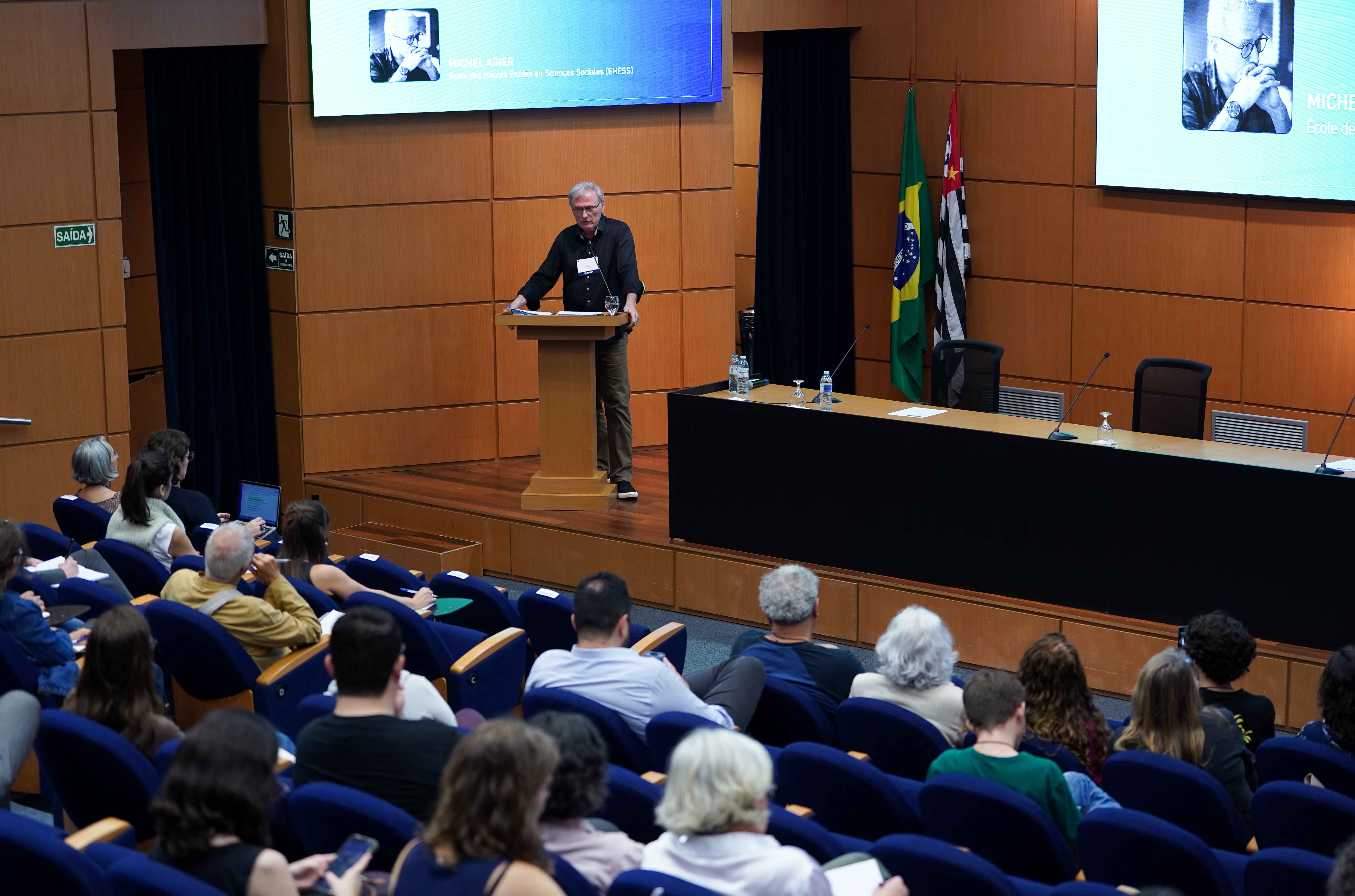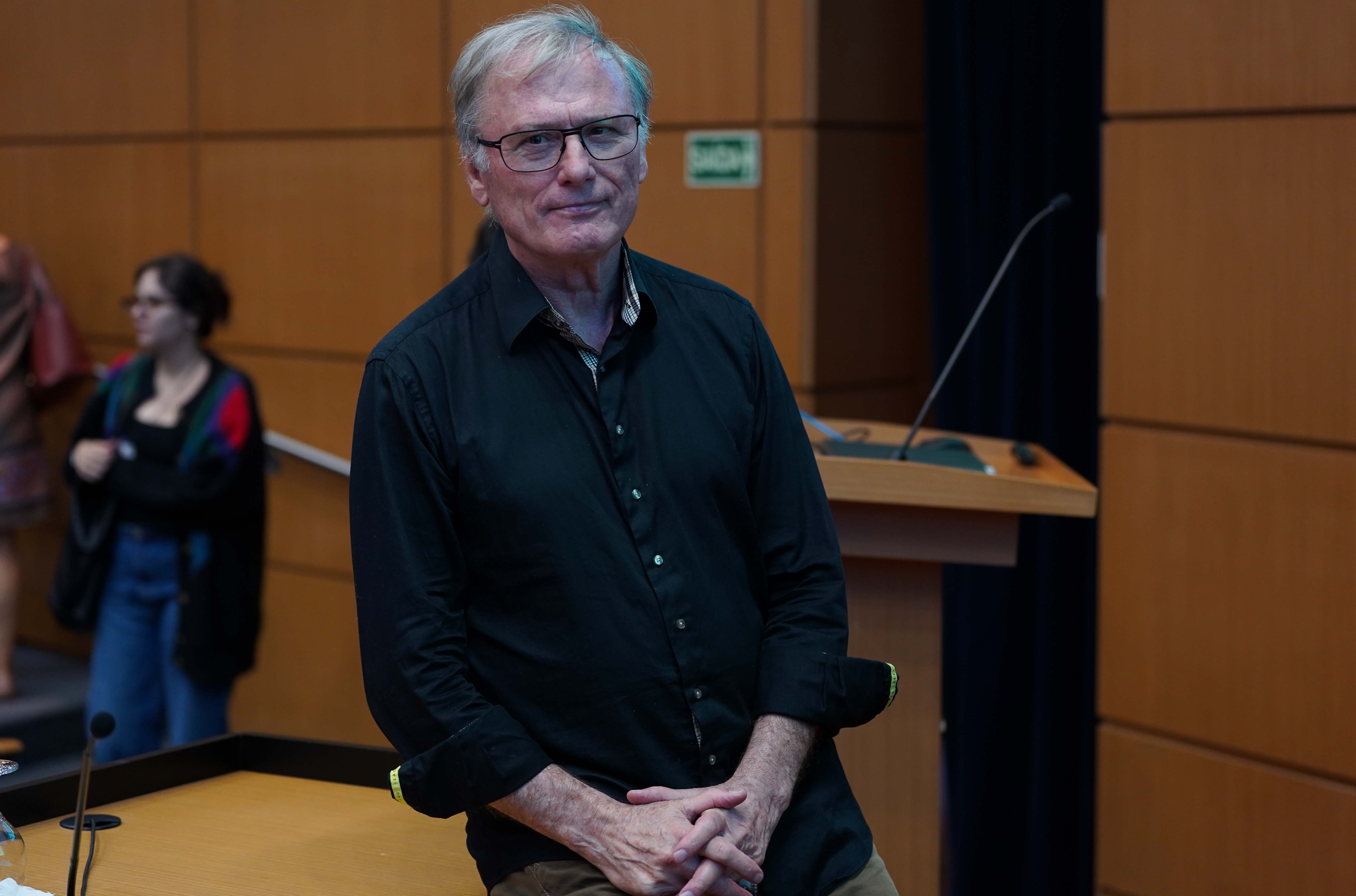


After the 2015 migrant crisis, Agier began investigating what he called the “crisis of otherness” (photo: Daniel Antônio/Agência FAPESP)
Published on 05/05/2025
By José Tadeu Arantes | Agência FAPESP – “Undesirable is not a new word. A priori, it doesn’t refer to anyone. It’s simply everything that’s alien to our world, that comes from outside and that we imagine could be threatening or disturbing”: with this statement, the French anthropologist and ethnologist Michel Agier summarized the central idea of his lecture, the second of the FAPESP 2025 Conferences cycle.
Born in 1953 in the city of Orange, Agier is director of studies at the École des Hautes Études en Sciences Sociales (EHESS) in Paris and senior researcher emeritus at the Institut de Recherche pour le Développement (IRD). His academic career has been marked by research on globalization, migration, exile, urban marginalization and the role of refugee camps. He has carried out extensive fieldwork in West Africa, Palestine and Latin America, particularly in Salvador (Brazil) and Cali (Colombia).
His research addresses issues of social mobility, ethnic and racial identities, and cultural performances in peripheral urban contexts. Since the 2000s, he has devoted himself to the study of refugees and migrants in urban peripheries and camps, developing a critique of the supposedly humanitarian policies of European governments. Among his most influential works are Gérer les indésirables (2008), La condition cosmopolite (2013) and Les migrants et nous (2016). In 2024, he published Ilê Aiyê: the factory of the Afro world, the result of his long relationship with Brazil.
Although his conference is part of a series of debates focused mostly on the climate crisis and preparations for COP30, Agier pointed out at the outset that his topic was not so different: “It’s about both the ecological and anthropological deregulation of the planet. That’s why we urgently need a cosmopolitical emergency to deal with the climate emergency.”

(photo: Daniel Antônio/Agência FAPESP)
Since the migrant crisis of 2015, Agier has been investigating what he calls the “crisis of otherness.” One of the central concepts of his analysis is that of “undesirability” – a notion constructed at the level of words, as well as practices and images. “In refugee camps, which are both places of refuge and exclusion, this ambivalence is very clear: do the camps protect the foreigners, or do they protect us from the foreigners?”
Drawing on etymology, Agier recalled that the words “hostility” and “hospitality” come from the same Latin root and share a constitutive tension. “This duality, or ambiguity, is embodied in notions that, being close, denote both the enemy and the guest,” he said.
According to Agier, the figure of the “undesirable” emerges precisely from this intersection: “What’s common to all situations is the fact that undesirability is experienced through the impossibility of crossing a threshold, a border, a limit.” He notes that the term was already officially used in administrative documents in the 19th century, in countries such as Brazil, the United States, Germany and France. But today it is reappearing with force in political speeches and police reports, especially in Europe. “Young, racialized men of sub-Saharan or North African origin are labeled as undesirable because of their ethnicity, economic insecurity, age and gender,” he said.
For Agier, undesirability is expressed on several levels: legal, social, symbolic and affective. “The principle of undesirability has to do with Hannah Arendt’s idea of superfluousness: to make someone undesirable is to make it possible for them to disappear.” This process, he explained, takes place in camps – refugee camps, detention camps, administrative detention camps – which are already the first step toward disappearance. “Whoever is in a camp is outside the social space, the citizen space.”
Agier showed that on the fringes of Europe, since the 2000s, and more sensitively since 2015, the plight of migrants has never stopped. “Governments wanted to appear protective of their residents and citizens, calling foreigners a threat to the security and identity of their countries. The walls, the expulsions, the mass controls, the intimidating police presence at the borders, the closing of the ports to lifeboats were meant to reassure the residents – supposedly terrified by the specter of an unknown but dangerous predatory foreigner.”
And this went so far as to deprive that spectral foreigner of the human rights that the same European countries so proudly defend as universal, including the most fundamental of all: the right to life. At least 55,000 migrants have died at Europe’s borders since the mid-1990s. This figure is a minimum estimate because many deaths are not officially recorded.
But indifference to the life of the “other” is not limited to the “other” who comes from outside, it also extends to the “other” who has always been inside. In the case of Palestine, Agier was explicit: “The Palestinians have been made foreigners in their own land. And when an Israeli minister says that the inhabitants of Gaza are ‘human animals,’ it takes on a performative function. To call someone an animal is to say that they can be killed. That’s the height of undesirability.”
A highlight of the conference was the analysis of the role of images in the construction of the contemporary social imaginary. “We’re in a world of images. And these images produce fear or compassion. Never indifference,” Agier observed. “The images that circulate about migrants are carefully edited to provoke reactions. If the focus is closed, we see a poorly dressed, threatening mass. If the shot is open, we see that there are only a few people. The composition of the image is political.”
Despite the bleak picture, Agier did not shy away from affirming the possibility of resistance – not only as a political gesture and ethical horizon, but also as a convivial practice. He mentioned the African concepts of Zumunti, Teranga and Ubuntu as ancestral ways of relating to others that can offer models for a cosmopolitics of hospitality. Zumunti, in the Hausa language (spoken in northern Nigeria, Niger and other West African countries), refers to a relationship of protection and welcome that extends the concept of family. Teranga, in the Wolof language (spoken in Senegal), denotes a principle of reciprocity: whoever receives hospitality undertakes to return the gesture in the future. And Ubuntu, in the Xosa language (spoken in South Africa), which can be summed up in Nelson Mandela’s maxim “I am because we are,” expresses the idea of a generic humanity, a principle of interdependence and mutual recognition that sustains life together.
“These concepts come from Africa. But they’re universal. And they offer a fundamental contribution to universalism. To recover these terms is to affirm that cosmopolitics is indispensable. And that it depends on an awareness of the common life and the need for solidarity that links the different scales of our planetary existence,” Agier concluded.
The 2nd FAPESP 2025 Conference “International Migrations: Practices and Languages of Hostility and Hospitality” was chaired by Marta Arretche, professor at the University of São Paulo (USP), researcher at the Center for Metropolitan Studies (CEM) and general coordinator of Sciences, Humanities and Arts at FAPESP. It was moderated by Ana Carolina Maciel, professor at the State University of Campinas (UNICAMP), where she holds the Sérgio Vieira de Mello Chair, created through an agreement between UNICAMP and the United Nations High Commissioner for Refugees (UNHCR).
The 2nd FAPESP Conference 2025 “International Migrations: Practices and Languages of Hostility and Hospitality” can be viewed in full at: www.youtube.com/live/FN7wXjQkXpk.
Source: https://agencia.fapesp.br/54641